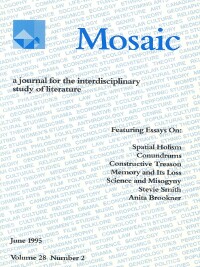Issue 28.2
Overview

General Issue
Published: April 1995
See the issue summary and contents below.
7 essays, totalling 152 pages
$15.00 CAD
This issue of Mosaic includes essays focusing on text-centred forms of contextualizations, postmodernism and Pedro Calderón’s Life’s a Dream, William Godwin’s understanding of truth, William Wordsworth and neural Darwinism, D.H. Lawrence’s relationships and thermodynamics, postmodern Realism and Anita Brookner’s photography, and psychoanalytic readings of Stevie Smith’s novels.
Spatial Cognition in Literature: Text-Centered ContextualizationMichael Hollister This essay identifies the coordinates of a “holistic” literary criticism based on spatial metaphors, correlating neurophysiologic research, Frye’s “anatomy” of literary structures, psychological theory, and recent linguistic investigations of the orientational dynamics of figurative language. Challenging current pedagogical trends, the essay argues for a text-centered form of contextualization. | |
Calderón’s Conundrums, or: Where Do You Draw the Line?Wojciech Sadurski Life’s a Dream is read as a treatise on the subversion of lines conventionally drawn between different spheres: between life and dream, between essential and merely contingent attributes of human beings, between genders, and between pre-determination and free will. The essay argues that Calderón’s views are consistent with a “post-modern” interpretation of the self and modern rational-choice theory. | |
Constructive Treason and Godwin’s Treasonous ConstructionsRanda Helfield In Caleb Williams and Cursory Strictures, William Godwin claimed that legal “truths” exist independently of language. This essay reads both works in the light of eighteenth-century treason law and modern critical theory to explore the connection between law and narrative, and the way that Godwin’s writings deconstruct his own philosophy. | |
Theories of the Mind: Wordsworth’s Anticipation of Neural DarwinismMichael G. Miller The major postulates of Neural Darwinism, Gerald M. Edelman’s recent revolutionary theory of how the mind works, are shown to have been intuited in William Wordsworth’s poetry. This essay also discusses the mutual antipathy of both men to the various mechanical models of the mind prevalent in their respective eras. | |
The Thermodynamics of Gender: Lawrence, Science and SexismMichael Wutz D.H. Lawrence’s thinking is examined in terms of the science that was most visible in his day: thermodynamics. Framed by the interdisciplinary theories of Michel Serres, the essay argues that thermodynamic protocols and theorems operate as organizational models in Lawrence’s world and become a paradigm for his management of gender relationships. | |
Stevie Smith’s Écriture Féminine: Pre-Oedipal Desires and Wartime RealitiesCatherine A. Civello Using the psycholinguistic theories of Jacques Lacan and Julia Kristeva, this essay reads Stevie Smith’s three novels with a focus on the female protagonists’ psychosexual development. The pre-oedipal and mirror stages parallel the characters’ reluctance to separate from the mother-figure and form intimate attachments to other adults. | |
Preserving Appearances: Photography and the Postmodern Realism of Anita BrooknerDeborah Bowen In Anita Brookner’s novels, the authority of the photograph’s apparently transparent reference to the real world is undermined to become an ironic commentary on the narrative illusion of control. Yet Brookner’s concern, as a postmodern realist, is not only with the illegitimacy but also the psychological necessity of preserving appearances. |